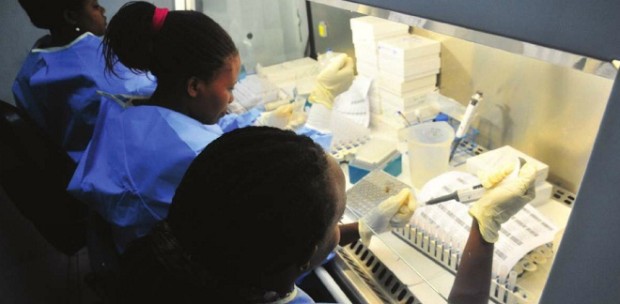New viral load tests for HIV pile pressure on national laboratories

The fight against new and emerging diseases and the emphasis placed on surveillance and testing before treatment are piling pressure on Uganda’s laboratory services.
At the centre of this fight is the Central Public Health Laboratories (CPHL), a government facility comprising top of the range testing equipment and professionals charged with coordinating public laboratory activity across the country.
The laboratories are housed in an aging grey-walled four-story block on Buganda Road in the Kampala City central business district. Together with an adjacent singlestory annex, the labs are oddly located amidst a bevy of small eateries, offices, boutiques and general merchandise shops.
Behind the walls is a small army of blue lab-coat clad professionals either hunched over computers or taking notes from reading on hi-tech-looking machines, seemingly endless rows of test tubes and test sample slides on green plastic trays.
The laboratories test for two main diseases; HIV/AIDS and sickle cell anemia. Despite the beehive of activity, the dominant sound here is silence. It is a hot zone for some of the most dangerous disease causing organisms known to humans and visitors are given one rule: “Don’t touch anything when you enter”.
Dr. Charles Kiyaga is the coordinator of CPHL. He says the lab receives about 5000 samples every day and is open 24 hours a day, seven days a week.
“We work to ensure that results are out in three to five days,” he adds. The numerous brown boxes that seem to compete for space with the people speak volumes about the amount of work.
The facility is grouped into three main departments; the HIV viral load lab, the Early Infant Diagnosis (EID) lab, and sickle cell lab. The latter is relatively new and is squeezed into two cubicles that can barely accommodate five workstations each on the third floor. It tests blood samples of babies suspected to be sicklers.
In a sign of how big a challenge HIV/ AIDS remains in Uganda, of the three laboratories housed here, the one that tests viral load in HIV patients is the busiest and occupies the most space with six laboratory rooms covering the second and third floors.
The Early Infant Diagnosis (EID) lab which focuses on testing babies that are born to HIV positive mothers is in the annex.
According to Dr. Kiyaga, the coordinator, the labs were set up to manage countrywide disease diagnosis challenges and are a focal point for laboratory services in the Ministry of Health. Established in 2011, CPHL is run by about 50 full time workers, interns and volunteers who are tasked with investigating and carrying out surveillance of diseases across the country.
They also coordinate other public laboratories across the country to ensure that they conform to the recommended standards.
Innovating to thrive
Faced with the heavy task, the CPHL officials have had to be innovative. For viral load testing which involves quantifying the amount of virus in a milliter of blood of a HIV patient, Kiyaga says the lab previously used plasma test. This test, which uses the fluid part of the blood, is considered the gold standard. But plasma samples are very complex to handle and store.
To overcome those challenges, CPHL switched to another tests; the Dry Blood Spot (DBS) testing. Here the blood is filtered and samples stabilized (dried) before being transported to the lab where it is prepared into solution form to re-activate it.
The DBS has proved convenient for collection of samples from the farthest parts of the country. The laboratories started viral load and EID testing inAugust 2014 collecting blood from facilities in Kampala. This was a year after the World Health Organisation (WHO) recommended viral load as the standard tool for monitoring patients on HIV treatment, from the widely available CD4 testing for monitoring immunity.
They recommend viral load monitoring six months after starting treatment, at 12 months, and every 12 months thereafter. While viral load testing remains a huge challenge in many countries inAfrica with only one in four patients having access, the CPHL had byAugust 2015 just a year after starting the programme done 132,000 tests from 712 facilities in 87 districts. To do this, they again had to innovate. They developed a national sample transport system which involved setting up hubs across the country to be collection centers for testing samples.
Each centre is allocated a motor bike to rotate around other health centers within 30 to 40kms to pick the samples before finally posting them to CPHL. The samples arrive in huge parcels of about 50Kgs each, according to Joyce Nambogo, a sample reception supervisor. The samples are in separate envelopes in the parcel.
Nambogo oversees the sample sorting to ensure that they have all the necessary details which qualify them to be tested based on a strict colour code. The Viral load samples come with a green sticker. The EID ones come with a pink sticker and are fewer; about 200 EID envelopes per day. The majority is for viral load, says Nambogo.
Most of the activity at the lab takes place in the data room where about 20 workers use computers to carefully determine each test. Their work was eased when the laboratory acquired the high end testing machines calledAbbot m2000 Real Time System. These are machines almost the size of a big deep freezer and capable of running 94 samples every three hours. The labs have eight machines of these high precision machines.
“If one has less than 1000 copies with use of plasma, then it means one has been adequately suppressed. In DBS, if it’s below 500 copies you are adequately suppressed,” Kiyaga explains. Kiyaga says although the machines were a grant, the cost of maintaining them is stretching the facilities budget. “We can’t use any other reagents apart from those produced by the manufacturer of the equipment. It’s still very expensive. They also need to be serviced,” Kiyaga says.
While one has to pay $20 to $30 (approx. Shs70,000 to 100,000) for a viral load test in a private facility, Kiyaga estimates that the government spends about $9.4 (Approx. Shs30) on each test, which is a big discount.
Good early results
“Just five years ago such tests were a preserve of the rich. People who would get a chance to do a viral load test here were those participating in research” says John Bosco Nambale, one of the centre’s biggest clients. He is the head of laboratory services at Rakai Hospital in Rakai district which, at 12%, has one of the highest prevalence rates of HIV/AIDS.
Nambale’s hospital sends five parcels of samples to CPHL every week. In an interview with The Independent on Mar. 24, Nambale said since the CPHL programme was rolled out in the district in January last year, a bike collects blood from different health centers on a daily basis to Rakai hospital which is the hub. Already, Nambale is noticing a positive in HIV/AIDS patient management change.
He says previously, the doctors often failed to detect high viral loads in patients with normal CD4 cell counts. The new CPHL system of viral load testing changed that. “With CD4, it takes time to discover that one is not being suppressed causing the virus to mutate.
When such a virus is spread to another person; that line of drug can’t work for them,” says Nambale, ““With viral load, you can detect early that the drug is not working or may be the virus is resisting the drug.” While Uganda is one of the countries in Africa that still grapple with a high HIV burden to the highs of 7.3% prevalence rate, the country’s unique approach of monitoring patients on treatment could hold the key to stopping new infections in the future.
“When one’s viral load is kept low by being consistently on treatment, the virus is suppressed to the extent that the chances of infecting their partner is greatly reduced,” says Dr. Joshua Musinguzi, the Manager of theAIDS Control Programme at the Ministry of Health. According to Nambale, the biggest problem now is getting people to test for the first time.
He says many people do not know their status, even in Rakai which is believed to be where the disease was first discovered. But more testing means more work for CPHL. Fortunately, CPHL is expecting new equipment.
With it, the facility has set a target of doing 800,000 tests in 2016. This means the majority of the patients on ARVs will be monitored just in line with the UNAIDS target of 90.90.90 for 90% viral suppression for those living with HIV by 2020.
 The Independent Uganda: You get the Truth we Pay the Price
The Independent Uganda: You get the Truth we Pay the Price


